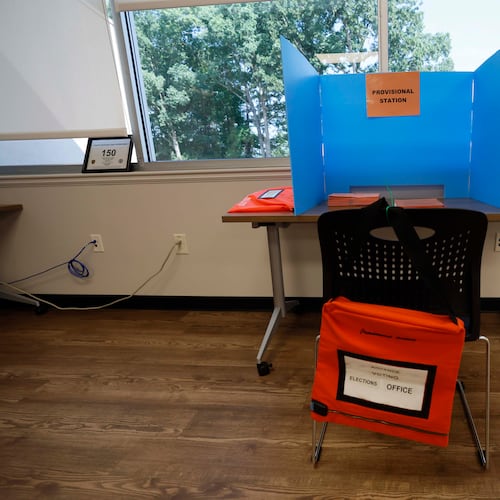When Georgia began using computer-printed paper ballots in 2020, they raised a new issue: Votes are scanned from bar codes that are unreadable by the human eye.
The inability to verify that the text of a ballot matches the contents of the bar code raised concerns from election integrity advocates, who said voters can’t be sure that their ballots were counted as they intended. They’ve warned that bar codes could be manipulated by hackers, though there’s no evidence that has ever happened.
Now, state election officials are weighing whether to replace bar codes with ballots that display candidate names with ovals next to them. A U.S. cybersecurity agency, in a report that found vulnerabilities in Georgia’s voting equipment, recently said local governments can choose to eliminate bar codes.
While no decision has been made to change the ballot design seen by every in-person voter in Georgia, the secretary of state’s office has been discussing the idea for over a year, Chief Operating Officer Gabriel Sterling said. Election officials are considering security, costs and challenges of printing a longer ballot.
Georgia began using printed-out paper ballots in 2020, ending 18 years of electronic voting by purchasing $138 million worth of voting equipment manufactured by Dominion Voting Systems. Paper ballots provide a way to hand count and audit results.
The voting system relies on a combination of touchscreens and printers, which produce a sheet of paper that includes a bar code — called a QR code — along with a human-readable list of the voter’s choices. Then, voters insert their ballots into optical scanning machines that read the bar code, which counts as the official vote.
By comparison, there wouldn’t be a QR code if Georgia began using ballots with every candidate listed. Currently, printed-out ballots only show the candidate chosen in each race.
Sterling said the secretary of state’s office is considering the advantages and disadvantages of the change.
“We’re not just being stubborn for no reason. There are legitimate election administration issues,” Sterling said. “You will often have two-page printed ballots, which then makes auditing much more difficult and raises costs. ... You’re trading one set of problems for another set of problems.”
Alex Halderman, a computer science professor at the University of Michigan, said a ballot that prints every candidate’s name next to filled-in ovals would be less vulnerable to manipulation than a summary ballot with a QR code. To tamper with how a computer reads a full ballot, a hacker would have to change how bubbles are counted or how candidates are displayed, which he said is more difficult to pull off than altering a QR code.
“The traditional ballot format is going to be better for voters because voters are able to verify the part of their ballot that gets counted,” Halderman said. “If the QR code is manipulated, you don’t have a chance that any individual voter is going to be able to look at that QR code and say, ‘Hey, wait a minute, there’s a problem with this ballot.’ ”
Other election authorities disagree with the premise that eliminating QR codes would increase security.
Ben Adida, executive director of VotingWorks, a company that assisted Georgia’s manual audit of the 2020 presidential election, said the QR code debate is little more than a distraction.
“If the attacker is able to change the way a ballot-marking device prints the ballot, the attacker can just as easily flip the names on a bubble ballot,” Adida said. “The QR code changes nothing in the security of the system.”
In Colorado, which also uses printed-out ballots for in-person voters, election officials are already moving forward with a change from QR codes that was announced in 2019.
Colorado has certified a version of Dominion’s software that includes the option for a full ballot, and a spokeswoman for its secretary of state’s office said it intends to mandate statewide use in the near future.
Outside Georgia and a few other jurisdictions, few voters cast ballots that rely on QR codes. About 70% of U.S. voters cast ballots filled out by hand, with ovals next to candidates, according to Verified Voting, an organization that focuses on election technology.
About the Author
Keep Reading
The Latest
Featured




